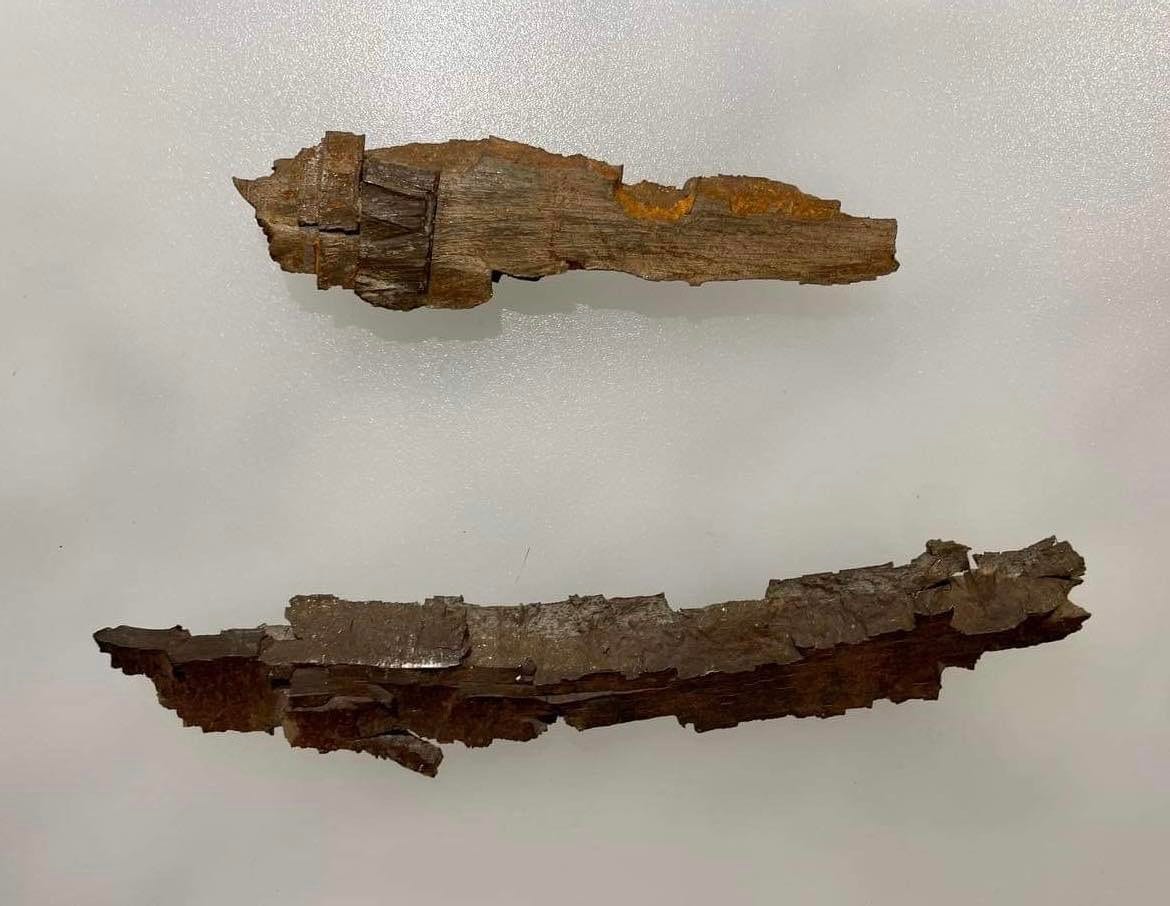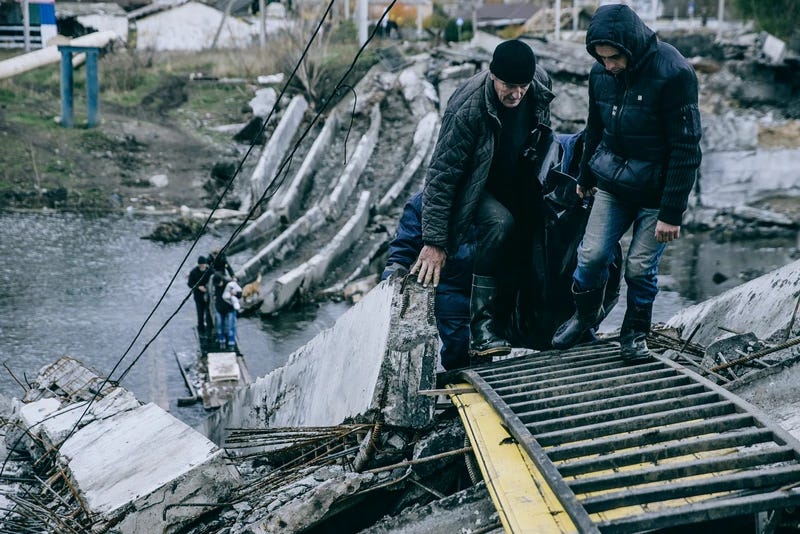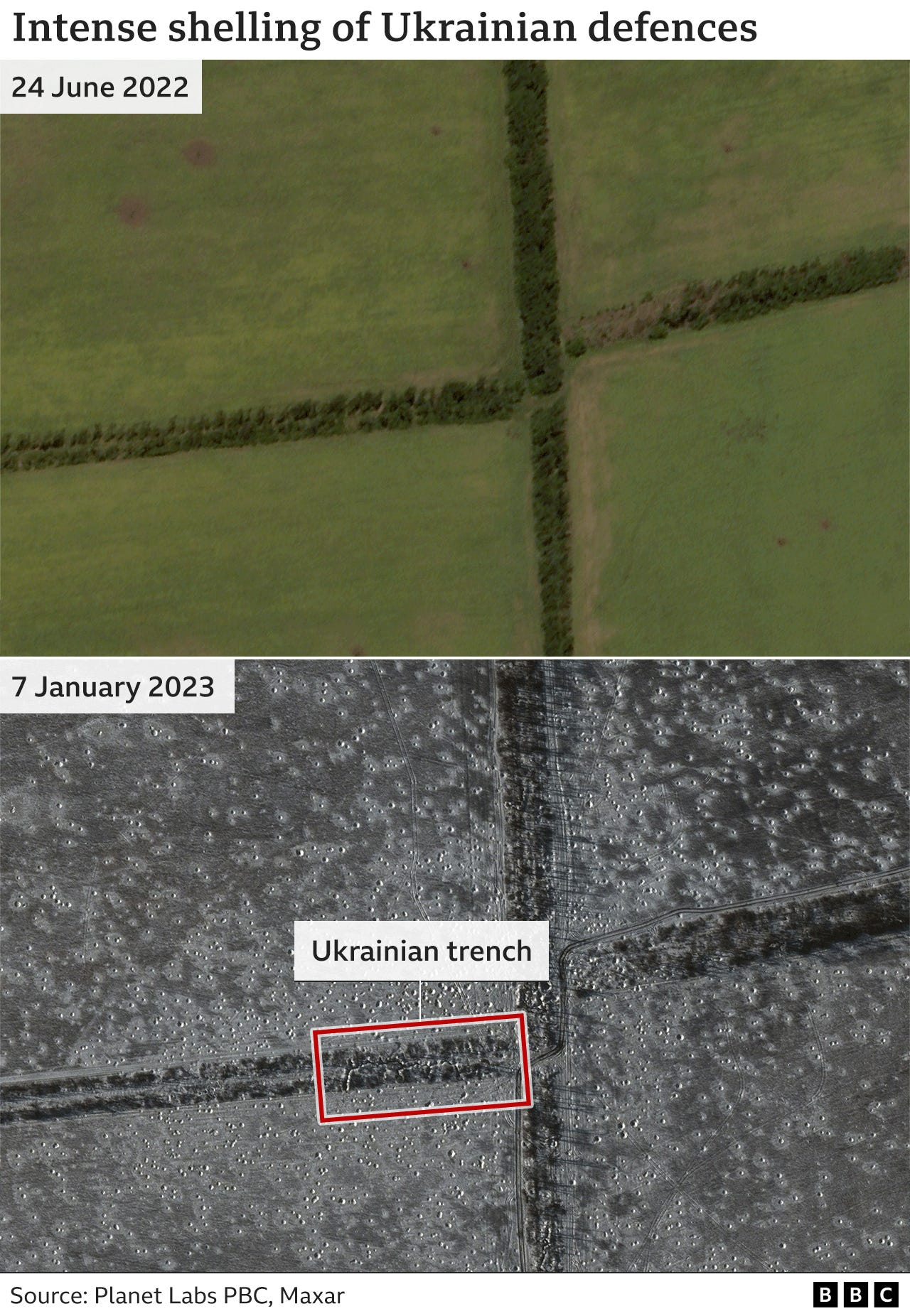The photo above shows two pieces of shrapnel. The top piece hit my grandfather in the leg outside his headquarters on the beachhead at Anzio in the winter of 1944 after the Allied landing there. The leather of his cavalry riding boot caused it to glance off his leg, tearing the leather and leaving only a flesh wound, thankfully.
The lower piece of shrapnel went through the canvas door of the Humvee that was two vehicles behind me in Iraq in December of 2003. It came from a 155 mm artillery shell which was buried on the side of the road our four-vehicle convoy was traveling along just outside of the headquarters of the infantry company I was staying with. Remotely detonated by insurgents, the explosion killed no one and no one was wounded, thankfully, although the soldier manning the machine gun in the back of that Humvee truck was knocked unconscious by the blast.
This is an article about the artillery that produces such shrapnel. There have been numerous stories in the press lately saying that the war in Ukraine has turned into “an artillery war,” with the Russians and Ukrainians standing back and firing artillery barrages at each other. There have been many photos of the damage Russian artillery has done recently, particularly to the towns of Bakhmut and Soledar where the heaviest fighting is said to be taking place. Here is a photo of men in moving a body across a destroyed bridge in Bakhmut.
An artillery gun is a fearsome weapon. An American 155 mm howitzer – and its Russian equivalent -- fires a round that weighs 95 pounds. Eighty pounds is steel, with the remaining 15 pounds being TNT or Composition B explosive inside the steel casing which explodes the projectile on impact, or if using a proximity fuse, when it gets close enough to its target to go off. An artillery round is deadly for two reasons: the projectile breaks apart when it explodes producing the kind of very, very sharp pieces of steel called shrapnel shown above. The shrapnel tears into flesh and kills or wounds human beings.
The explosion of an artillery round also produces blast – the generally spherical shockwave that goes outward and upward from the point of impact with enormous force – enough force to kill by itself if a human being is close enough, or to bring down buildings and bridges and other structures made of strong material like concrete and steel. (The blast, if it hits the ground, also leaves a hole called a crater, more about which later.) Wooden structures, if hit by artillery, simply explode outward from the blast and are destroyed. The machine gunner in the Humvee behind mine was not killed because the 155 mm projectile had been buried behind a concrete curb which sent the explosion upward in a conical manner. We were lucky that the Iraqi insurgents who buried the projectile had tried to hide the spot behind the concrete curb, because if it been buried shallowly in the open ground, it would have created a spherical blast sending shrapnel in every direction, likely hitting the Humvee full-on, killing the driver, passenger and the machine gunner.
The Russians have been stymied in their attempts to take the towns along the front lines in the east of Ukraine. The Ukrainians know the territory. They are using ruins of buildings as defensive positions from which to fire on the Russians. Much of the ground around Bakhmut and Soledar is flat, open fields that in normal times would produce wheat and barley and other crops, making Russian advances on Ukrainian positions difficult if not impossible. So, the Russians sit back and fire artillery at places they think Ukrainians are dug in. The satellite photos below are from Planet Labs PBC Maxar and show an area outside of Soledar.
The BBC identifies the top photo as agriculture fields in June of last year. The green areas are a freshly planted crop of some kind. The bottom photo was taken by satellite last week on January 7, and according to the BBC shows “how Ukrainian trenches in fields around the town have been targeted by Russian artillery.”
I disagree with this assessment of the satellite photos. The dark areas crossing in the photos are not trenches. They are lines of trees that pre-dated the photos and were planted to separate agriculture fields and provide crops protection from the wind. Although the Ukrainian army may have dug into the tree lines and used them for concealment and protection, the tree lines appear to be intact and were not significantly damaged, even by the artillery strikes. In the top photo, you can make out an open area in an “S” shape where tractors are driven from the fields on the top to the fields on the bottom.
The BBC says, correctly, that the bottom photo shows the impact of artillery in the fields on all four corners of the cross in the middle. The craters are clearly seen as little circles darkened on the left side, as the photo was probably taken in the late afternoon or early morning when the sun was shining from the left, leaving shadows in each crater.
But examining the photo more closely, you can see that there are tracks of a vehicle that has traveled along the top of the tree line on the right and crossed over to travel down the trees running vertically through the bottom of the photo. The width of the track of a typical military truck or tracked vehicle is about eight feet. If you look closely, the diameter of the craters is almost exactly the width of the tracks running along the tree lines. In the upper right quadrant, you can even see where a truck or tracked vehicle drove around a crater, making a little bulge in the tracks.
The difference in the coloration of the ground in the lower photo is significant. The darker areas are ground left by a harvested crop. Around the craters, especially around concentrations of multiple craters close together, the ground is lighter. This is the dirt thrown up by the blast from the explosions. Look closely: You will see a line of five or six significantly larger craters about a quarter of the way up from the bottom of the photo. These may be from a single barrage of rockets from a mobile rocket launcher, but who knows? Maybe artillery rounds just fell onto ground that was softer, creating larger craters.
What this photo really shows is how wildly the Russians are wasting artillery ammunition. CNN reported on Tuesday that Russian artillery fire is down as much as 75 percent in some areas in recent days. “Russia may be rationing artillery rounds due to low supplies, or it could be part of a broader reassessment of tactics in the face of successful Ukrainian offenses,” CNN reported, quoting Ukrainian and U.S. officials.
I’ve got another explanation. Untrained Russian soldiers are just firing 155 mm howitzers willy-nilly, wasting enormous quantities of ammunition. The howitzer crews appear to have been given coordinates for a strike, but the fire is so wild, it landed everywhere. The Russian soldiers may be just incompetent, or they may be rebelling against their commanders and wasting ammunition on purpose, but the end result is the same: hundreds of rounds of 155 mm projectiles very clearly landed in open fields and in the tree lines creating craters and killing no one. The craters go all the way to the edge of the satellite photo, indicating that there are more of them in ground not seen by the satellite.
I found a pamphlet online from the School of the Battery Commander at Fort Sill, Oklahoma called “School of Fire for Field Artillery: 75 mm Gun and 155 mm Howitzer.” The pamphlet shows line drawings of craters in open ground from 155 mm howitzer fire. They are 3.5 meters in diameter and 1.5 meters deep, about the measurements I estimated from looking at the tracks in the satellite photos and comparing them to the craters. The craters in the photos look exactly like the line drawings in the Artillery School pamphlet.
There is a big cost to putting an ill-trained army into a war and giving them big guns and telling them to shoot at the enemy without any accurate targeting information. What happens can be clearly seen in this satellite photo taken from an area near Soledar last week. Russia is claiming today that they have taken the village of Soledar. Ukraine claims they still have soldiers in Soledar and it has not fallen completely into Russian hands. There are also reports that Russia has suffered heavy casualties in the battles for Bakhmut and Soledar.
This is why Putin’s army is losing the war. Russian artillery, firing guns with a range of 15 to 18 miles, were safely back in the rear area shooting at open fields and tree lines, evidently killing no one. All the shrapnel from those 155 mm howitzer rounds ended up buried in the soil of Ukraine. Farmers will be digging it up for decades.






In the Great War, millions of rounds of artillery shells fell into the soil of northwestern France, and by estimates, some 30-40% of those shells were duds that never exploded. Even today, hundreds of shells are exposed by erosion or other means and god knows how much toxic chemicals leach out of those other buried shells contaminating the soil and groundwater? Ukraine will be scarred by those artillery rounds for generations, thanks to that homicidal psychopath in the Kremlin…
I've still, and will until the end of my days, got what I believe to be Russian shrapnel in my leg, my pack was peppered with it, enough to set off the smoke grenades inside, but I was 6" from having the lot of it in my chest which was covered in M-79 grenades, 40 of them I think, 1/2 of a step less and I would have come home in a box and not a med-evec, the concussion was enough to throw me back 15' and break my back. Every single day for over 50 years now I am reminded of the cost of serving our country, no complaints here, I was able to keep a friend alive who the Dr's told him would have surely died without me, that by itself was enough reason for me to have been there. I look at those images and think the people firing those rounds can't have any idea what they are doing. You can look at those dots that are craters, there are thousands of them, and figure that each one represents a hundred dollars or more, I really have no idea what they cost but I know that they aren't free, and that Russia has an economy smaller than Texas, so this is going to bankrupt them eventually, have at it boys. It's like trying to put out a fire with hundred dollar bills, if you have enough maybe you can, that has been a tried and true technique in the movie industry for decades, but maybe you just burn up a shit load of money, my guess is that the Russians are doing the latter, like I said, have at it boys. The Ukrainians will eventually dig it up, melt it again, and maybe use it to build bridges but they won't be to Russia. They are still mining that stuff out of the ground in Belgium where the armies had at each other in WWI and will for another hundred years or more. The breadbasket of the world indeed, imbecilic putin is sowing it with iron and steel, with any luck he'll be eating some of it himself soon.